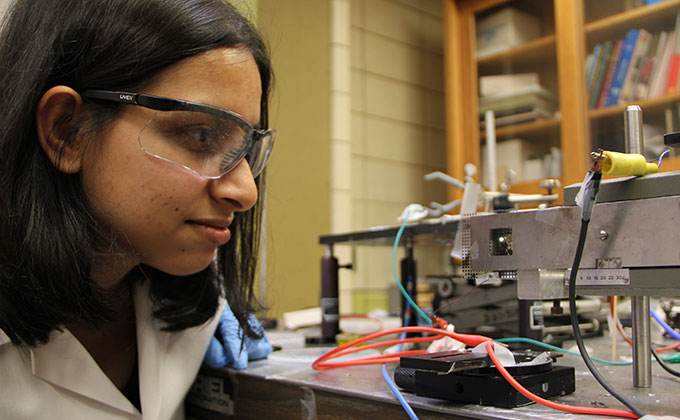The U.S. Department of Energy’s Ames Laboratory has developed a near ultra-violet and OLED that can be used as an on-chip photosensor. The OLED can emit UV light at 400 nm in wavelength.

“The real pie in the sky goal is a tiny chip that is a whole spectrometer, so it can measure the absorption or luminescence spectrum of anything that can absorb or emit light. This is a step in that direction,” said Ames Laboratory scientist Joseph Shinar.
Relatively little research has focused on OLEDs in the UV range. While the consumer electronics industry has been highly interested in visible OLEDs as lighting and phone and small format displays, little research has focused on OLEDs in the UV range. “And that [research] has failed to address a rising demand of small-size, flexible devices for analytical applications,” according to Ames Laboratory associate Ruth Shinar, a scientist at Iowa State University’s Microelectronics Research Center.
“Such devices can be used for detection in food safety, water quality, medical diagnosis and other fields where biosensing is necessary. They can be hand-held, used in the field, and potentially inexpensive and disposable.”
The researchers exploited the effects of optical microcavities. On either side of an optical medium, the reflective surfaces can form microcavities. The small size of microcavities alters the behavior of light wavelengths. The researchers can use these altered characteristics from the microcavities to tune the UV OLEDs with narrower emission spectra to specific wavelength emissions for sensing and optical excitation. When an array of such OLEDs is fabricated, multiple optical excitation and analyses can be performed on the same device.
The researchers built on previous Ames Laboratory microcavity OLED work to create a device that could emit light in the wavelength range of deep blue and near ultraviolet of 370nm to 430 nm to the ultraviolet range. The new research expands upon the previous developments in the visible range.

Graduate student Eeshita Manna examines OLED Array
Graduate student Eeshita Manna performed the experiments and Ames Laboratory scientist Rana Biswas simulated the spectra. Further research performed of former graduate student Emily Hellerich extended the range to 470 nm using a unique combination of two photoactive polymers, PVK and CBP. Combined with an earlier study on visible microcavity OLED arrays, they can now cover the 370 to 640 nm range.
Two papers discuss the science of the research: Deep Blue/ultraviolet microcavity OLEDs based on solution-processed PVK:CBP blends, published in Organic Electronics and Tunable Near UV Microcavity OLED Arrays: Characterizations and Analytical Applications, appearing in Advanced Functional Materials.




